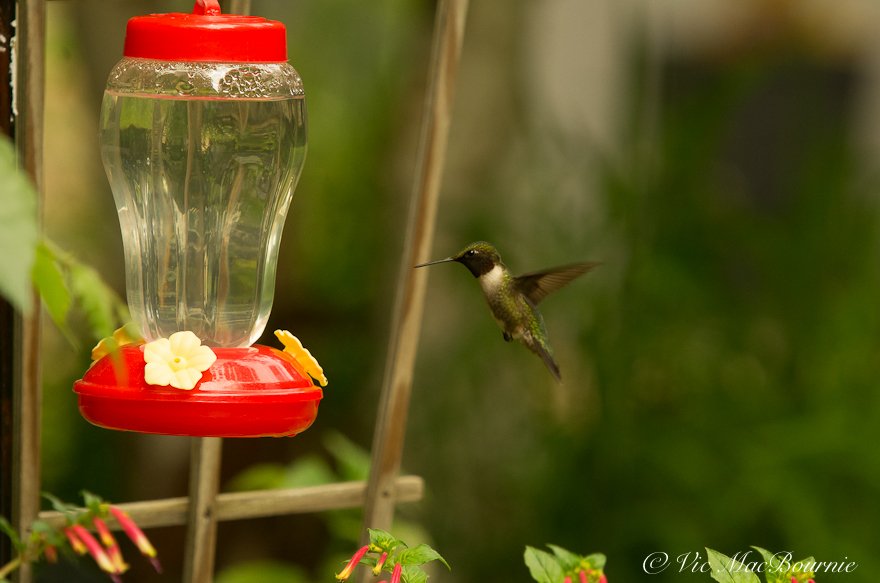How to make nectar (sugar water) for hummingbirds
Aim for a combination of natural and commercial hummingbird feeders
Hummingbirds are truly remarkable creatures and providing them with homemade nectar (sugar water) in our feeders is a great way to watch them up close. By making homemade nectar, we can attract hummingbirds to our yards in early spring on their migration routes and then use native flowers to keep them in our backyards all summer, where they will raise their young.
Once we have encouraged them to stay and raise their families, there is a good chance they will return year after year.
Their vibrant colours, tiny size, and incredible flying abilities, have captured the fascination of gardeners and nature enthusiasts all over the world.
Attracting them to our backyards by providing feeding stations is very different from feeding other birds in our backyard.
• Check out this post for more hummingbird images and digital creations.
It’s always best to provide natural nectar by growing many of the native and non-native plants that hummingbirds feed on. Cardinal flowers, columbine, cuphea, fuschia, trumpet vine, bee balm and salvia are just a few of the flowers hummingbirds are attracted to in our gardens. These vibrant blooms will not only provide a natural food source for hummingbirds but also add beauty to your garden.
For more on attracting hummingbirds to your garden, check out my earlier posts: Cardinal flower, Best plants to attract hummingbirds, How to photograph hummingbirds.
For more on hummingbirds in the garden, check out the following posts:
• How to help Hummingbirds during migration
• Five tips to attract hummingbirds
In our backyard, I have even created a “hummingbird haven” that is aimed at focusing our hummers on a corner of the yard where there are several feeders – both natural and commercial feeders – as well as a water feature and perches where the birds can rest. For more, go to my recent post on the hummingbird haven.
How to make nectar for hummingbirds
Making nectar to feed hummingbirds is not difficult, but there are steps you can take to ensure it is a healthy choice for these little birds.
First, let’s dive deeper into understanding their favourite food – nectar, and how we can make it at home.
Hummingbird nectar is a simple mixture of sugar and water that closely mimics the natural nectar found in flowers. The key ingredient is white granulated sugar, as it provides the necessary energy for hummingbirds.
Avoid using honey, brown sugar, or artificial sweeteners, because they can be harmful to these tiny birds.
What is the ratio of sugar to water
The ratio for making hummingbird nectar is important to ensure the right balance of sweetness.
The recommended ratio is four parts water to one part sugar.
For example, you can use one cup of sugar with four cups of water. This ratio closely matches the sugar concentration found in many flower nectars and provides the optimal nutrition for hummingbirds.
It’s crucial to dissolve the sugar completely in hot water before cooling the mixture. This helps prevent fermentation and ensures the nectar stays fresh for longer. Remember to always use plain, unchlorinated water, as chlorine can be harmful to hummingbirds. Boiling the water helps to remove any chlorine that might be present in the tap water.
By understanding the ingredients and ratios for hummingbird nectar, you'll be able to create a delicious and nutritious treat that will attract these beautiful birds to your garden.
Now that we know the ingredients and ratios for hummingbird nectar, let’s dive into a step-by-step guide on how to make it at home.
First, gather your supplies: a clean container, white granulated sugar, and plain, unchlorinated water.
Start by boiling four cups of water. Once the water reaches a rolling boil, carefully measure out one cup of sugar. Slowly add the sugar to the boiling water, stirring continuously until it completely dissolves.
This hot mixture helps prevent fermentation and ensures the nectar stays fresh for longer.
Next, allow the nectar to cool completely before pouring it into your hummingbird feeder.
It’s important to never use hot nectar in your feeder, as it can harm the delicate beaks of hummingbirds. Once the nectar has cooled, carefully fill your feeder with the homemade nectar.
Our hummingbird corner has been set up to encourage hummingbirds into a corner of the yard where we can better watch and photograph them.
Make extra nectar to always have a supply ready
I like to double up on the recipe and store it in the fridge to either top up my feeders or refill them BEFORE the nectar begins to ferment. In addition, it is not uncommon for insects to squeeze into the feeders and quickly contaminate the nectar. By having a ready supply in the refrigerator, keeping the nectar fresh is much easier.
Remember to clean your feeder thoroughly before refilling to prevent the growth of harmful bacteria. Place the feeder in a shaded area, away from direct sunlight, and enjoy watching the hummingbirds flock to your garden.
By following this simple step-by-step guide, you’ll be able to create a delicious and nutritious treat for these enchanting creatures.
Now that you know how to make homemade hummingbird nectar, let’s explore some tips for attracting and caring for these delightful creatures.
Looking to add a hummingbird feeder to your garden? Here are some of the best feeders available at Amazon.
Hummingbirds have a high metabolism and need to consume large amounts of nectar daily.
Regularly cleaning your feeders prevents the growth of harmful bacteria and ensures the health of the hummingbirds.
It’s also important to place your feeders in a shaded area, away from direct sunlight. This helps to keep the nectar cool and prevents it from spoiling too quickly.
Lastly, consider providing perches or small branches near your feeders. Hummingbirds often rest between feeding flights and having perches nearby allows them to conserve energy.
By implementing these tips, you'll create an inviting environment that will attract and care for hummingbirds, bringing joy and wonder to your backyard.
A little background on hummingbirds
If you are just embarking on feeding hummingbirds, or want more information about these tiny birds, here is some background that might help you on your journey.
Did you know that hummingbirds are the smallest birds in the world? They weigh less than a nickel and can beat their wings up to 80 times per second.
These tiny powerhouses can fly in any direction, even upside down, and reach speeds of up to 60 miles per hour. Their unique ability to hover in mid-air and move with such agility is simply awe-inspiring.
Hummingbirds are also known for their iridescent feathers, which can shimmer and change colour depending on the angle of light. This makes them appear like living jewels, adding to their allure.
Additionally, hummingbirds have an incredibly high metabolism and need to consume large amounts of nectar to fuel their energy. They play a crucial role in pollination, as they transfer pollen from flower to flower while feeding.
So, not only are they beautiful to observe, but they also contribute to the health and diversity of our ecosystems. Now that we have a glimpse into the fascinating world of hummingbirds, let's dive deeper into understanding their favorite food - nectar, and how we can make it at home to attract these delightful creatures.







